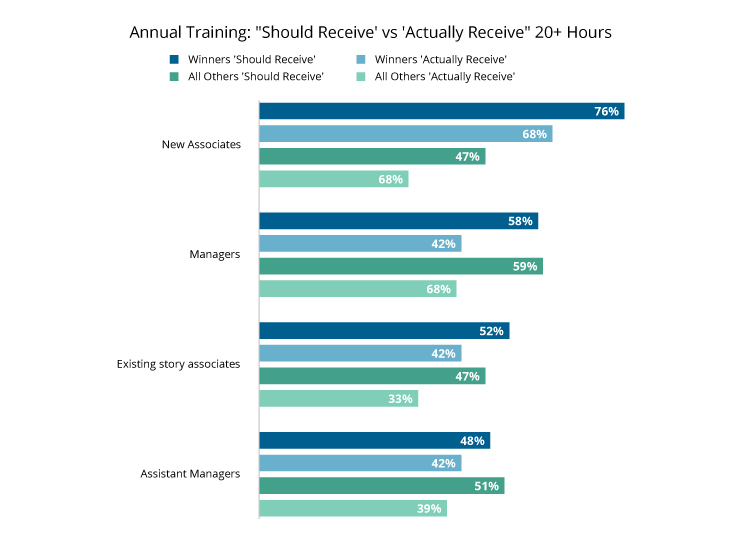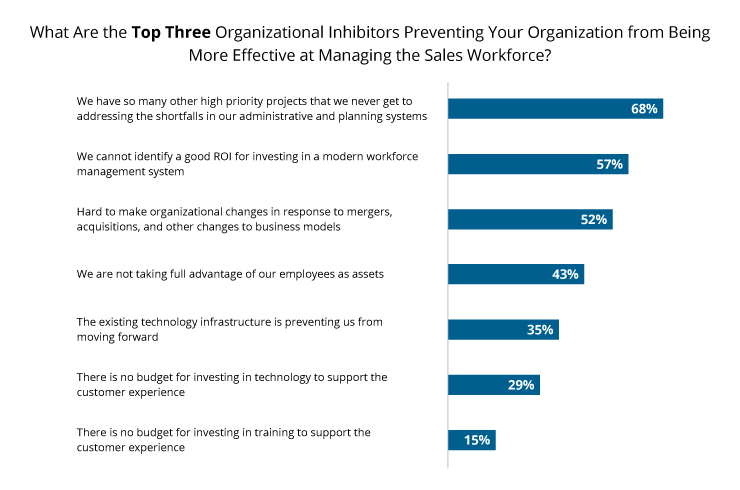What Is Preventing Retailers from Winning with Workforce Supporting Technology?

Then, COVID happened, and stores were shuttered, causing the entire industry to tighten its belt. Suddenly, these new workforce management platforms (that experts had predicted would take 6-7 years to slowly permeate most workplaces) were sorely needed. Overnight the entire industry had a quantum leap in technology that empowered their workforces. The old excuse of “If it ain’t broke don’t fix it” was instantly shattered as retailers were forced to shut down and had to do whatever they could to stay afloat, leading to many embracing the many benefits that come with modern workforce management.
The analysts at RSR Research recently released the benchmark report Has the Era of The Empowered Workforce Finally Arrived? where experts observed and analyzed the change in how retail organizations view their workforce and employee supporting technology. You’ll see that there is a marked difference in the ways that empowered workers are viewed between top-performing retailers and their struggling competitors.
Here are some key takeaways from that study:
What’s Holding Retailers Back?
Despite greater usage of workforce management solutions, there is a distinct hesitation in both retailers that have implemented them and those that are still holding out. When asked what prevented organizations from investing in these platforms, the top stated inhibitor is consistently “Other High Priority Projects”. This is the case for all companies across the board regardless of current performance. (This is followed by “Difficulty identifying ROI” despite research showing an average ROI of over 12 times for every dollar invested.)
Forty percent of Retail Winners (categorized by RSR as those over-performing retailers reporting more than $5 billion in annual revenue) indicate that other priorities push WFM improvements to the back burner. For average sized and smaller retailers (defined as organizations with revenue under $250m annually), 100% report that other priorities are the top inhibitor. For RSR or any study, “100%” response to anything is a remarkable statistic.
It is rare to find unanimity in any study of moderate complexity or size, and yet delaying digital employee supporting solutions is labelled uniformly by these groups to be the primary reason for procrastination. These inhibitors block organizations from progressing properly and prevent workers from becoming ideal modern-day retail associates.
As we’ll see, that viewpoint may be more short-sighted than it appears at first glance.
Training Is Key (But Only If You Follow Through)
Though it would seem intuitive that employee training is important, there are still some outmoded beliefs in the retail industry that prevent training from being a top priority. Many organizations still have a “churn and burn” approach to their workforces, where workers are seen as temporary. This practice involves over-demanding from workers until they burn out and resign, while maintaining a perpetual (and costly) hiring process that replaces workers as they leave. In this modern era where workers have more options than ever, retailers that operate in this downright feudal state will find it difficult to maintain any kind of labor force.

In this new era, the value of individual employees is finally being appreciated, and with it, the importance of training has been acknowledged as well. Seventy-six percent of Retail Winners have committed to at least 20 hours a year of training each new employee. Average and under-performers lag behind where less than half commit (47%) to 20 hours of training (and less than 1/3 of them don’t follow through on that commitment anyway).
While the majority of retailers agree on the level of training needed, there is a distinct difference between the Winners and everyone else. Top performers tend to follow through on commitments and invest in new employees. Average and under-performers want employees to commit time first. This creates a paradoxical “chicken and egg” scenario wherein managers want to wait until employees are valuable to train them, yet the employee will not BECOME valuable until they are trained.
This leads to our final takeaway:
Management’s Biggest Obstacle Is Themselves
While there are plenty of differences that vault Retail Winners over their competitors, this RSR Report has found something that consistently predicts which organizations succeeds and which don’t: How much importance the organization places on employee-supporting technology. Ninety percent of largest retailers (>$5B annual revenue) assign high value to employee portals, while only 54% of retailers overall do. Eighty percent assign high value to real time employee performance while only 51% overall do the same. When it came to mobile communication devices for store employees for customer engagement, high value was assigned by 67% of high retailers and 55% of all others.
Consistently, the top performers place more importance on these areas of improvement. While it is understandable for underperforming businesses to be hesitant about investing in new technologies, it appears these employee supporting platforms could be just the thing to improve their standing. By repeatedly passing on new improvements, these managers find themselves in the same “chicken and egg” paradox that was mentioned in the last entry. While others have better opinions on these technologies, philosophies of empowering employees, and implement them to find greater success, the average and under-performing “laggers” undervalue and underprioritize the very tools that could be improving their fortunes right here and now.
The majority of retail respondents indicate that they are moving quickly to address shortcomings that they may have in empowering their store employees. But the numbers don’t lie; those who commit and follow through to supportive empowering technologies become the leaders of their market. Those that hem, haw, wait, and procrastinate find themselves floundering; unable to compete with the market leaders, and unwilling to make the changes necessary to thrive.
Don’t be a “Chicken or the Egg”, it’s time to shake a leg! If your organization is ready to pull off the band-aid and become a “Retail Winner” by engaging with your workforce using mobile employee supporting technology, read the full report, Has the Era of the Empowered Workforce Finally Arrived?, and learn how to get involved in this exciting new future for the retail industry.
Subscribe to The WorkForce Blog
Learn the art and science of maintaining productive, happy, engaged employees.
Discover More
Nucleus Insights from WorkForce Customers Research Note
Nucleus Research interviews WorkForce customers who validate why we’re ranked the #1 WFM enterprise vendor for 10 consecutive years.
Elevate Employee Experience: Checklist for Operational Leaders
Get the practical steps and technology functionalities operation leaders need to improve their employees’ work experiences.
Streamlining Complex Workforce Compliance Requirements Boosts Productivity
Discover how workforce compliance software helps EMEA organisations navigate complex legislation, enhance compliance and boost operational efficiency.




